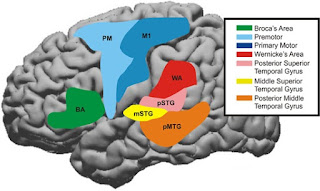Characteristics of normal speech
 |
Areas of Speech in Brain |
Speech is the verbal means of communicating.
The components of speech includes -
•Articulation
How speech
sounds are made - pronunciation
•Voice
Use of the
vocal folds and breathing to produce sound
•Fluency
The ease and flow of speech
•VOICE
•QUALITY OF VOICE:
speaker’s speech
is considered to be normal and good when it posses good quality of voice, means
pleasant and intelligible.
• PITCH:
Speaker should
use his optimum pitch where output is maximum with less vocal efforts.
That means he
should not deviate from his optimum speech.
Pitch should
not be too high, too low or monotonous or stereotype.
• LOUDNESS:
the speaker’s
loudness should be normal i.e. in range of 40-80 dB.
•Articulation
INTELLIGIBILITY
OF SPEECH: clarity of speech
•Fluency
RATE OF
SPEECH:
• It
refers to the number of words or syllables uttered in a particular time period.
•Speakers rate
of speech should be 140 words/minute & 300 syllables/minute or 2.5
words/second & 7syllables/second.
•Being too
fast may result in omission of syllable and articulation may not be similar.
INTONATION:
•Intonation means
variation of pitch or fluctuation of pitch during delivery of speech.
• Speech
is considered having good characteristics when there is proper use of
intonation or inflexion (tone).
RHYTHM:
It refers to
easy and smooth flow of speech or continuity of speech.
•A good
speaker’s easy flow of speech can be observed during his delivery of speech
that means he should not have any struggle or effortful speech neither he
repeats, hesitates, pauses nor stops in syllables.
STRESS:
It refers to
extra pressure given on particular syllable during speech.
Speaker is
considered to have good speech if he doesn’t lay stress on making us clear his
speech.
•All Parameters or components of speech are
normal
•CHARACTERISTICS OF DISORDERED SPEECH
•Articulation – Misarticulation - Difficulty in producing speech
Distortion -
A speech
sound is distorted when it sounds more like the intended phoneme than another
speech sound but is conspicuously wrong.
The /s/
sound, for example, is relatively difficult to produce; children may produce
the word “sleep” as “schleep,” “zleep,” or “thleep.”
•Some speakers have a lisp; others a whistling
/s/.
•Distortions can
cause misunderstanding, although parents and teachers often become accustomed
to them
Substitution:
• Children
sometimes substitute one sound for another, as in saying “train” for “crane” or
“doze” for “those.”
• Children
with this problem are often certain they have said the correct word and may
resist correction.
•Substitution of
sounds can cause considerable confusion for the listener.
Omissions:
•Children may
omit certain sounds, as in saying “cool” for “school.”
•They may
drop consonants from the ends of words, as in “pos” for “post.”
•Most of
us leave out sounds at times, but an extensive omission problem can make speech
unintelligible.
Additions:
•The addition
of extra sounds makes comprehension difficult.
•For example,
a child might say “buhrown” for “brown” or “hamber” for “hammer.”
•Voice
A voice disorder can be defined as a problem involving abnormal pitch, loudness or quality
of the sound produced by the larynx, more commonly known as the voice box.
Almost every
disorder may present in more than one symptom and one cannot
associate one single symptom with one specific voice disorder.
•
For example, hoarseness, increased vocal effort or
limitations in pitch and loudness may be a sign of any number of disorders.
Severity of
the voice symptoms varies according to the disorder and the individual.
Voice disorders
may be present in both adults and children.
•Misuse, abuse or overuse of voice
•Tips should be followed to take care of voice
-Hydrate yourself well
-Don’t take too much caffeinated drinks,
aerated drinks
-Don’t shout
-Less consumption, oily foods and spicy foods
•Fluency
•Stuttering affects the fluency of speech. It
begins during childhood and, in some cases, lasts throughout life.
•The disorder
is characterized by disruptions in the production of speech sounds, also called
"disfluencies."
•Most people
produce brief disfluencies from time to time.
•For instance,
some words are repeated and others are preceded by "um" or
"uh." Disfluencies are not necessarily a problem;
however, they can impede communication when a person produces too many of them.
•"W- W- W- Where are you going?" (Part-word
repetition: The person is having difficulty moving from the "w" in
"where" to the remaining sounds in the word. On the fourth attempt,
he successfully completes the word.)
• "SSSS ave me
a seat." (Sound prolongation: The person is having difficulty moving from
the "s" in "save" to the remaining sounds in the word. He
continues to say the "s" sound until he is able to complete the
word.)
No comments:
Post a Comment